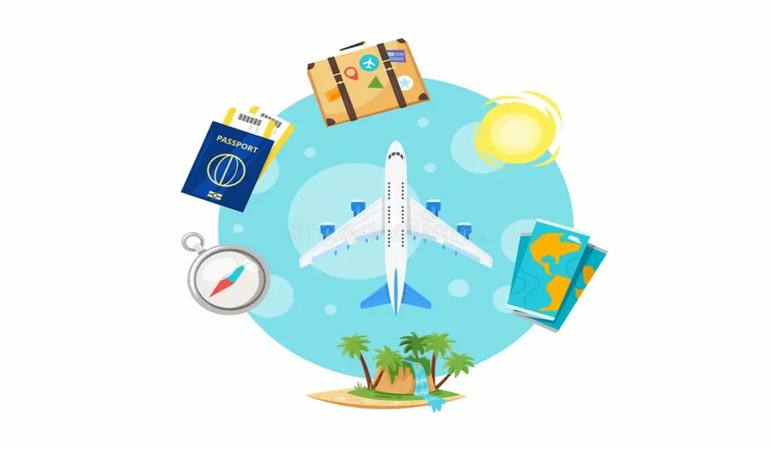Tourism Advertisement

Yes, here are five different title options for a tourism advertisement focused on the keyword “tourism”:
- “Discover the Wonders of Tourism: Your Ultimate Guide to Memorable Adventures”
- “Unveil Hidden Gems: The Thriving World of Tourism Awaits You”
- “Tourism at Its Best: Explore, Experience, and Embrace New Cultures”
- “Embark on a Journey: Elevate Your Wanderlust with Unforgettable Tourism Experiences”
- “Sustainable Tourism: Travel Responsibly and Make a Positive Impact on the World”
Overview of Tourism Advertisement
Tourism advertisement refers to the marketing efforts to promote travel destinations, experiences, and services to potential travelers. This can include various forms of media such as print ads, digital marketing, social media campaigns, video content, and public relations initiatives. The primary goal of tourism advertisement is to attract visitors by highlighting the unique features, attractions, and cultural experiences that a destination has to offer.
Importance of Knowing Tourism Advertisement

Understanding tourism advertisement is crucial for stakeholders in the travel and hospitality industry, including destination marketers, hotel owners, travel agencies, and government tourism boards. Knowledge of effective tourism advertising strategies can lead to enhanced visibility and competitiveness in the market.
Relevance in Strategic Decision-Making

- Target Audience Identification: Having a good understanding of tourism advertising makes the stakeholders capable of finding and segmenting their target audience more exactly. This, again, is a license for the creation of personal marketing messages, which can touch a varied number of people, the upshot of this, should be engagement and conversion of the newly introduced product.
- Resource Allocation: Being well-versed in tourism advertising can be one of the worthwhile moves for selecting the right marketing channels or the best allocation of your marketing budget. With digital media growth and the right paradigm, a consistent strategy can both minimize costs and maximize reach.
- Brand Development: Tourism advertising, if done properly, is viewed as one of the most important aspects of brand development. Through the construction of the brand story and the design of the brand image, the companies can become a distinct brand that draws attention in a crowded market. Awareness among customers about a firm’s brand determines its future.
- Monitoring Trends: The tourism industry is highly dependent on the changing preferences of consumers, the economic instability faced by various countries, or the dire events happening around the globe. Learning about tourism advertising trends is a very shrewd investment in education that allows companies to be ahead of the game and to move their strategies with the trends.
- Measuring Impact: The comprehension of the various layers of tourism advertising would provide the companies with the opportunity to measure the success of their campaigns through analytics and performance metrics that are specifically introduced for projects. This knowledge-based method has turned into a norm for sound decisions in real-time future business.
In conclusion, the tourism ad experience can either doom or lift one on his decisions towards one’s success as well as – financial and environmental – continuity in the travel market.
Tourism Advertisement: Definition, Purpose, Functions, and Real-World Applications
Definition:
An advertisement of tourism is a skilled method of stimulating destinations, travel experiences, and related services by purposefully urging likely travelers to visit certain locations. It is the combination of different ways through which the communication is made with the means of signing up for print and digital media to go outside the sign and publish the news and the social campaigns on the internet which are made to answer the questions about the objective of the tourist destination, and of conveying the culture, as well as the amenity that a tourist destination can provide.
Purpose:
Tourism advertisement’s main goal in attracting visitors is to increase economic and social development, job creation, and local culture propagation in the area. Advertisements are intended to bring out the best of a place, be it through the natural aesthetics, its historical significance, or the variety of adventure and food options. Tourism advertisement plays an essential role in the travel decision-making process of consumers when communication is done well, and experiences are communicated effectively. By combining addresses of drawbacks and proposals, tourism advertisements can influence the customer’s decision to travel.
Functions:
- Awareness Creation: Travel ads are responsible for bringing announcements about new scenery or Life to thousands of people who have never heard of them. It was a leap that can be a cornerstone of their customer’s business.
- Influencing Perception: Ads participate in the construction of the image-like entity of this place, affecting the way the tourists view it. It is fundamental for the destinations that want to establish their names or show a better image of themselves.
- Highlighting Unique Selling Points (USPs): Perfect advertisements demonstrate the outstanding features of a destination like unveils of different types and colors, heritage sites, food, or landscapes of rare beauty.
- Promoting Events and Packages: They organize events, tours, and packages, offering travelers one option over another through one-time price cuts and exclusive experiences.
- Encouraging Engagement: Utilizing calls to action, these tourism ads make us eager to click on the links, stay tuned by liking, sharing, or befriending, and especially, to make a reservation or two.
Real-World Applications:

- Social Media Campaigns: In fact, dozens of tourist boards and travel companies use Instagram, Facebook, and TikTok to circulate pictures of scenic places and provide visitors with information about their destinations. Campaigning, such as presenting a campaign with astonishing images of New Zealand, might turn out to be so interesting that it will make thousands of tourists think about going there.
- Influencer Partnerships: Through the agency of travel influencer collaborations, destinations accomplish the task of finding influential parties who then create real content. Thus, a first-class lodge can get a top travel influencer to undertake a trip to their resort and tell visually attractive stories to attract a wider demographic.
- Television Commercials: Theme parks, such as Disneyland, usually inject a certain level of realistic and engaging content into the ads. For instance, a brief commercial displaying the vibrancy and beauty of Italian culture could affect the audience in a way that makes them desire a trip.
- Print Media: And that’s something that generally works. I mean even travel agencies give travelers brochures that include excitingly mentioned itineraries and the right photos.
- Email Marketing: In buying/selling products travelers’ and bookers’ bargaining is one way travel agencies and tour operators implement email marketing success. Manufacturers email directly to potential customers with discounts and deals, which then results in increased bookings and repeat visits.
- Public Relations: Journalists and bloggers who hosted the press trips were able to spread information about the destination and by awarding publications with articles and features that spotlight places of interest, the idea of tourist attractions being a magnet is being techie. Thus, it is helping to bring brand awareness to the places.
In final, as the marketing tool in the domain of tourism, the advertisement is the main driver. However, this is done by making innovative marketing strategies effective through different platforms, making the tourists feel important and thereby, the whole area will make the economy grow.
Understanding Tourism Advertisement: A Crucial Element for Business Success
In the current competitive environment, tourism advertisement has become a vital tool in building up the strength of the tourism and hospitality industry. Not only is the understanding of this concept crucial, but it is a means to drive growth, appeal to customers, and be readily available to the public. This is the reason why, in the current situation, the subtle aspects of tourism advertising are central for these enterprises, and they can, therefore, come to dominate the market.
- Attracting Target Audiences

An effective tourism advertisement mediated the business association to be able to spot and relate to their niche market. Businesses should gain insight into the preferences, behaviors, and travel motivations of potential clients, and then they should make their marketing strategies align with these audiences to capture their minds. This method of being direct not only enhances both engagements but is a part of better conversion rates and eventually increased orders and sales.
2. Enhancing Brand Awareness

In a time when consumers suffer from information overload, it is harder than ever to be distinguished from competitors. Clever tourism advertising is the tool, which businesses use to stand aside among the producers. Using powerful images, catching stories, and certain techniques to capture their attention, companies can build a relationship between these activities and their brands, which is likely to result in increased connections and, in turn, in loyalty and trust.
3. Driving Economic Impact

Tourism is a major contributor to global economic infiltration. Such tourism getaway spots which are made identifiable and appealing through tourist advertising can, however, grant corporate and government contributions that comprise part of economic activities. Thus, local inhabitants, get benefit from the growth in the number of tourists which pays for various infrastructure and service necessities.
4. Leveraging Digital Platforms

In an ever-increasing digital era, familiarity with tourism advertisement is critical with the growth of online travel agencies (OTAs), social media, and influencer marketing. Companies that know how to utilize these platforms can reach a much broader audience as well as interact with potential customers in real time and make their strategies based on data-driven information. Adaptation is a necessity for companies to be competitive and be seen as modern by consumers.
5. Encouraging Sustainable Practices

The rise of eco-friendly consciousness among travelers makes understanding tourism advertising a step closer to promoting sustainable practices as well. Companies that give evidence of their dedication to sustainability through advertising their efforts not only draw in eco-conscious travelers but also ensure that such segment consistently grows. By introducing this method, businesses will not only enhance their brand reputation but also increase the number of loyal customers wishing to travel responsibly.
6. Building Relationships and Community Engagement

Besides informing potential clients, tourism advertisement also performs an important function in the course of building relations with the local population. Businesses that inform the community of the benefits of their presence can establish healthy partnerships with the local community. This cooperative way can result in well-coordinated actions that would make tourists feel more comfortable and satisfied, while at the same time, local needs are duly taken care of as well.
Conclusion
In synthesis, an extensive awareness of tourism marketing is the key to students who have in situational and sociocultural changes knowledge and are looking forward to starting businesses in the evolving travel (traveling) and tourism sector. The ability to gather core groups, take identifiers and brand (company) developers, companions to green who curb climate change, and change the urban environment, through digital means, thrilling events, and sustainable projects, are some of the points that need to be tackled first. Thus, both corporates and the whole tourism environment were flying high.
Successful Real-World Examples of Tourism Advertisement
Tourism advertisements are an essential factor in the process of luring tourists to different parts of the world. Here are some notable tourism campaigns from different countries that showcase talent and include visually compelling, strategic, and successful examples:
- Incredible India Campaign (India) In the year 2002, the Indian government officially introduced a historic and unique program named “Incredible India:” an image of autonomy, hegemony, and Prowess above all, by importing some of the best products from India. With such mesmerizing videos, stories of India’s rich civilization, as well as, biodiversity are displayed to the rest of the world. The campaign was often characterized by great emotional content and fun storytelling while, at the same time, it effectively challenged some of the stereotypes and used the arrivals of more resting tourists.
- I Need Spain Campaign (Spain) This tourism promotion campaign was put into practice to ensure that the economy does not collapse by raising the demand for the tourism industry as one of the rescue drivers after the financial crisis. It showcased key areas like gastronomy, cultural heritage, nature, wildlife, and adventure tourism in Spain. The factors of success of the campaign such as the most engaging use of social media, the ability to publish brands, and reliance on content generated by users made the campaign highly appealing which resulted in great achievements such as attracting more guests from largely held markets like the UK and, Germany.
- Visit Norway Campaign A campaign launched by the Norway tourism board, called “Visit Norway”, was designed to illustrate the beautiful natural sites and unique experiences the nation offers. The application of photographing the beach and exciting videos was a way of putting the light on the most sought-after and lesser-known places, eco-tourism promotion being an additional incentive for the visitors. As tourists were attracted to destinations focusing on nature and adventure, the new strategy generations international visits to the destination.
- The Great Land Campaign (Alaska, USA) The “Great Land” campaign was a very successful campaign that was designed by the Alaskan Travel Agency and presented the most beautiful and thrilling natural wonders of the place. Among various media like the internet and outdoor ads, the use of camping, hiking, and cruising as the groups to be targeted can be considered as their success. The gain was noticed with more significant extensive tour reservations and hotel accommodations in the region.
- OMG! I’m in (Singapore) The Singapore Tourism Board decided to launch the “OMG! I’m in” campaign, to influence the traveling habits of young people. Being a part of the campaign also means that one gets to eat nice food while experiencing nightlife. The plan was to attract the social media habits of young people alongside the strategic use of influencers and digital content. As a result, the number of tourists that chose to engage in the island state increased impressively, especially amongst the younger demographic.
- Wonders of Colombia Campaign Colombia’s tourism advertising was designed to promote the image of a country that is under the perception as being a secure and vibrant travel destination. The campaign which was focused on Colombian destinations, along the Caribbean beaches and the Andean mountains was realized with amazing visual storytelling and cultural narratives. So the actual number of tourists included was a big difference which was a critical factor for the transformation of a global view of Colombia and it would not been possible without the massive tourism sector development.
- Travel South Carolina” Campaign The public would become aware of the excessive attractions in South Carolina as such the historical sites, beaches, and hospitality would be involved. With its timely launch of a social media advertising campaign across web devices, it swiftly caught the attention of the whole members of families around the world who wanted to schedule their vacation trips. This, in turn, popcorns both domestic and international visitors which enhances the local economies highly dependent on tourism.
Conclusively, the efficient way is to stand out in the tourism advertisement through creativity, emotion, and technology to attract the masses of tourists. These are real cases that explain how the adopted plans can renew a place’s reputation and further tourism growth in a great way.
Understanding and Implementing Tourism Advertisement
Travel advertisement is a major tool in marketing destination places and visitor attractions, as well as in influencing the choices and experiences of travelers. In the context of an extremely competitive travel sector, precise advertising is a must for the promotion of places and their attraction to tourists.
The Need for Tourism Advertisement:
- Attracting Visitors: Effective tourism advertisement, which involves promoting different destinations, and offers unique experiences, cultural events, and natural scenery, is the one that is best received. It is performed to excite the tourist and arouse the tourist’s curiosity about the destination.
- Building Brand Identity: Tourism advertisement explains the way destinations create their online footprints, make a coherent report for the visitors, and provide them with a good experience as well as being the project that can distribute destinations. A strong brand presence can enhance recognition and influence perceptions, making a destination more appealing.
- Economic Impact: Increased tourism results in economic growth and job creation as well as aids in the provision of resources to keep businesses environmentally friendly. Effectively advertising the areas can result in more people coming to visit the area, owners of businesses obtaining more income, and local government receiving more tax money.
- Crisis Recovery: In a period of crisis such as the COVID-19 pandemic, the establishment of tourism advertisements, which is one of the most urgent steps, is necessary. Marketing techniques can reassure visitors about the use of safety measures and encourage travelers to think about traveling.
- Utilizing Digital Platforms: One of the types of tourism advertisement that has to be highlighted is the one referring to digital forms of advertising. There is no other field of modern technology that covers so many different types of travel advertisement, like social media, search engines, and sites designed especially for those who want to experience travel. The effective use of these platforms will ensure that the advertisement can address a wide audience, as well as travelers interactively.
- Consumer Behavior Awareness: Knowing the changing behavior patterns among customers is crucial to the development of tourist advertisements. To convey targeted messages, marketing firms must be updated on new travel trends, interests, and shifts in the demographic composition.
Implementation Strategies:
- Target Audience Identification: Identify the target demographic and learn as much about the potential tourists as possible to create counter-advertisements that entice them.
- Innovative Storytelling: Employ narrative and visual techniques that deliver on the promise of real experiences, culture, and natural scenic beauty, besides, prompting the audience’s emotional attachment to the whole narrative.
- Cross-Channel Marketing: Make print, online, and social media outlets fit in with one another while developing a coherent idea across them all generating both a more visible message and a larger public to view it.
- Utilizing Influencers: Work with popular travel bloggers and influencers to boost followers and improve credibility through truly honest advertisements and other like activities.
- Feedback Incorporation: Use visitor data and feedback as information sources continually to improve promotional methods by accommodating customer demands.
Conclusion
The importance of fully recognizing and putting in place tourism advertisements is indeed crucial. Apart from its role of attracting tourists, it is also a tool for building up economic sustainability and developing cultural exchanges. It is the advertising methods that are congruent with the audience that set the spots on the road to the sustainable development of the travel industry and its vitality.
